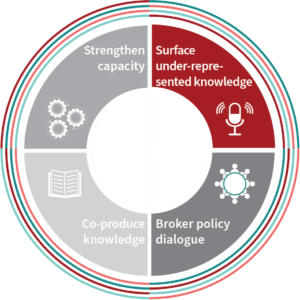Surface under represented expertise

Surfacing and amplifying under-represented expertise, particularly from the South, helps to generate relevant and contextualised global, regional and national public goods and policy debate. In doing so, we AMPLIFY for our stakeholders knowledge that is context-relevant.
Knowledge equity at NORRAG.
NORRAG envisions a world where everyone enjoys the right to equitable, quality, accessible lifelong education as a public and common good. Our mission is to actively participate in the creation of the conditions for more participatory, evidence-informed policy decisions that improve equal access to quality education. To do this, we are guided by principles of knowledge equity in our work at the interstices of knowledge, policy and practice.
We aim to surface and amplify under-represented expertise, particularly from the South, to generate relevant and contextualised global, regional and national public goods and policy debate. Our knowledge equity principles inform our commitment to co-produce and mobilise expertise with and from experts from the Global South in ways that address the globally uneven and unjust production, dissemination and use of research and evidence. Our knowledge equity practices aim to recognise – and begin to address – the complexities of these disparities.
We understand “Global South” to refer both to a geographical location and a political subjectivity born from the lateral solidarities among the world’s multiple Souths (Mahler, 2017). We also recognise that there are Souths in the geographic North and Norths in the geographic South – that is, that the term “Global South” should not conceal the multiple inequities existing within and across countries globally (Dados et al, 2012). Amplifying under-represented expertise to strengthen evidence-informed decisions involves taking account of these dynamics, as well as those that arise from the context of the knowledge, policy and practice area in question.
Our approach to knowledge equity is:
- Multi-level. We aim to surface and amplify expertise from Global South countries, and from experts globally whose work is under-represented at the nexus of research and decision making.
- Context specific. We acknowledge that determining what expertise is under-represented – and how it can be mobilised – is dependent on local, national, regional and global contexts; the context of existing knowledge and evidence; and the context of policy debate.
- Justice oriented. We recognise that knowledge equity involves paying attention both to experts (who is “at the table”) and expertise (what is “brought to the table”). Under-represented experts, including those from the Global South, continue to be marginalized due to historic and contemporary injustices. We aim to address this by surfacing and amplifying their work. Many factors play a role in shaping what expertise may be under-represented in a given policy, practice or research environment. We therefore aim to surface and amplify expertise that is excluded from or marginal in these contexts, to support a more equitable future for education as a public and common good.
How we monitor our knowledge equity principles
Knowing how successfully we surface and amplify under-represented expertise is central to our organisational learning. We are developing our MEL so that we can use these indicators contextually to assess our success.
- Geography
- Gender
- Career stage,
- Area of expertise and
- Stakeholder groups
This area relates to research and knowledge production in relation to our themes. This includes research and analytical work as well as various NORRAG publications such as NORRAG News (1986-2017), NORRAG Special Issue (2018-present), the NORRAG blog and working papers, some of which are also published in an adapted form in Mandarin Chinese, Arabic, Russian, French and Spanish. Furthermore, NORRAG produces audio and visual material and is present on Twitter, Facebook, LinkedIn and Vimeo.
For more information on our research and knowledge products, see our resources.
For more information, see our themes.
